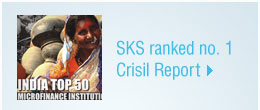
|

|
India has 800 million poor people who live on the brink of subsistence. This is one of the largest populations of poor in the world. The bottom 5% of India’s poor, considered “ultra poor”, face even deeper levels of chronic hunger, persistent poor health and illiteracy. To cope with their vulnerability, the poor have no choice but to take loan for consumption and income generation from money lenders that charge exploitative rates of interest. This can put the poor in a debt trap. If poor people can access loans with fair interest rates, they could break out of the cycle of poverty. Bureaucracy, corruption, illiteracy and challenging logistics prevent the poor from accessing loans from banks and the government. Microfinance in India started in 1974 in Gujarat as Shri Mahila SEWA (Self Employed Women’s Association) Sahakari Bank. Registered as an Urban Cooperative Bank, they provided banking services to poor women employed in the unorganised sector. Microfinance later evolved in the early 1980s around the concept of informal Self-Help Groups (SHGs) that provided deprived poor people with financial services. From modest origins, the microfinance sector has grown at a steady pace. Now in a strong endorsement of microfinance, the National Bank for Agriculture and Rural Development (NABARD) and Small Industries Development Bank of India (SIDBI) have committed themselves to developing microfinance. The microfinance sector has been "witnessing a tremendous growth" during the last few years in India in terms of loan portfolio, geographical area and outreach. With India’s GDP growing at the rate of 7.1 % the country’s socio-economic pyramid is turning around the story with millions of poor people becoming entrepreneurs.  MFI Model: The MFI model has gained significant momentum in India in recent years and continues to grow as the viable alternative to SHGs. In contrast to an SHG, an MFI is a separate legal organization that provides financial services directly to borrowers. MFIs have their own employees, record keeping and accounting systems and are often subject to regulatory oversight. MFIs require borrowers from a village to organize themselves in small groups, typically of five women, that have joint decision making responsibility for the approval of member loans. The groups meet weekly to conduct transactions. MFI staff travel to the villages to attend the weekly group meetings to disburse loans and collect repayments. Unlike SHGs, loans are issued by MFIs without collateral or prior savings. MFIs now exist in a variety of legal forms, including trusts, societies, cooperatives, non-profit NBFCs registered under Section 25 of the Companies Act, 1956, or Section 25 Companies, and NBFCs registered with the RBI. Trusts, cooperatives and Section 25 companies are regulated by the specific act under which they are registered and not by the RBI.. Attempts have been made by some of the associations of MFIs like Sa-Dhan to capture the business volume of the MFI sector. As per the Bharat Micro Finance Report of Sa-Dhan, in March 2009, the 233 member MFIs of Sa-Dhan had an outreach of 22.6 million clients with an outstanding microfinance portfolio of INR 117 billion (USD 2.5 billion). Self Help Group Bank Linkage Model: The microfinance movement started in India with the introduction of the SHG-Bank Linkage Programme in the 1980s by NGOs that was later formalized by the Government of India in the early 1990s. Pursuant to the programme, banks, which are primarily public sector regional rural banks, are encouraged to partner with SHGs to provide them with funding support, which is often subsidized. A self help group, or SHG, is a group of 10 to 20 poor women in a village who come together to contribute regular savings to a common fund to deposit with a bank as collateral for future loans. The group has collective decision making power and obtains loans from the partner bank. The SHG then loans these funds to its members at terms decided by the group. Members of the group meet on a monthly basis to conduct transactions and group leaders are responsible for maintaining their own records, often with the help of NGOs or government agency staff. |
 |











